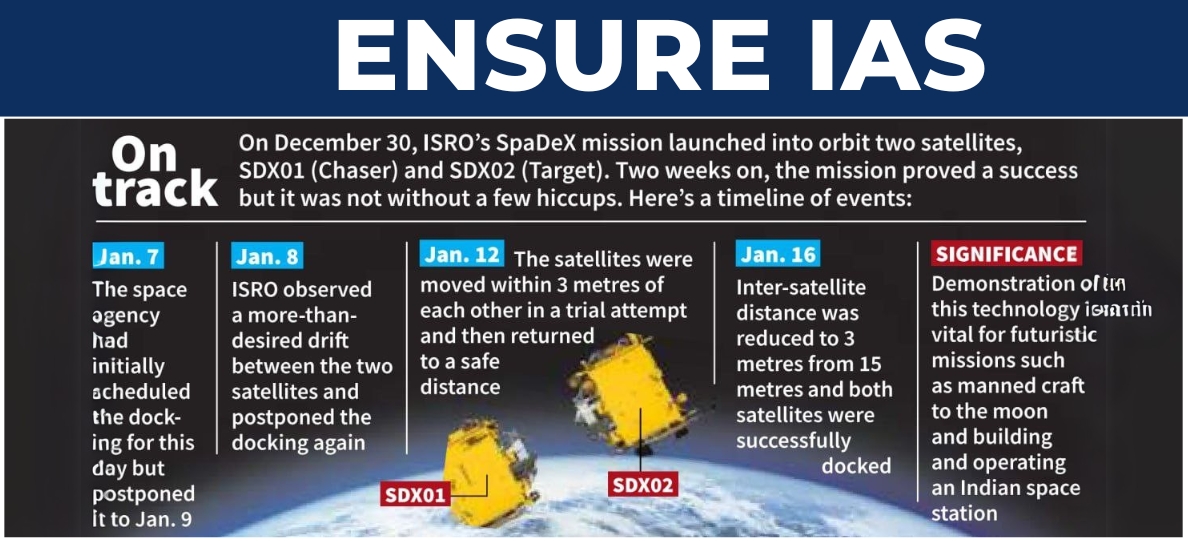- Courses
- GS Full Course 1 Year
- GS Full Course 2 Year
- GS Full Course 3 Year
- GS Full Course Till Selection
- Answer Alpha: Mains 2025 Mentorship
- MEP (Mains Enrichment Programme) Data, Facts
- Essay Target – 150+ Marks
- Online Program
- GS Recorded Course
- Polity
- Geography
- Economy
- Ancient, Medieval and Art & Culture AMAC
- Modern India, Post Independence & World History
- Environment
- Governance
- Science & Technology
- International Relations and Internal Security
- Disaster Management
- Ethics
- NCERT Current Affairs
- Indian Society and Social Issue
- NCERT- Science and Technology
- NCERT - Geography
- NCERT - Ancient History
- NCERT- World History
- NCERT Modern History
- NCERT Medieval History
- CSAT
- 5 LAYERED ARJUNA Mentorship
- Public Administration Optional
- ABOUT US
- OUR TOPPERS
- TEST SERIES
- FREE STUDY MATERIAL
- VIDEOS
- CONTACT US
Successful ISRO’s SpaDeX Mission: Space Docking Achievement
Successful ISRO’s SpaDeX Mission: Space Docking Achievement

- On January 16, 2025, the Indian Space Research Organisation (ISRO) successfully completed its SpaDeX mission, marking a historic milestone in India’s space program.
- ISRO successfully demonstrated the space docking of 2 satellites, making India the 4th country in the world to achieve this capability, joining the ranks of the United States, Russia, and China.
- The mission's success is a significant step toward enhancing India’s space infrastructure and advancing the country’s capabilities for future deep space exploration, lunar missions, and the construction of space stations.
-
Challenges Faced:
- The docking was initially planned for January 7, 2025, but was delayed due to an abort scenario.
-
- After several attempts and additional simulations, the satellites were successfully docked on January 16.
Key Data and Facts
-
Satellites Involved:
- SDX01 (Chaser Satellite): This satellite actively moved to approach the target satellite during the docking process.
- SDX02 (Target Satellite): This satellite was stationary, allowing the chaser to dock with it.
- Both satellites weighed 220 kg.
- Docking Distance: The satellites were brought within 3 meters of each other before the docking procedure was initiated.
- Mission Name: SpaDeX (Space Docking Experiment)
- Launch Date: December 30, 2024 using the PSLV-C60 rocket from Satish Dhawan Space Centre (Sriharikota).
- Orbit: The satellites were placed in a 475 km circular orbit around the Earth.
What is Space Docking?

Space docking is a process where two spacecraft connect while in orbit, allowing them to work together. This technology is crucial for:
- Space stations: To assemble large structures, such as modules that form a space station, in orbit.
- Interplanetary missions: For transporting equipment, crew, and fuel for long-duration missions.
- Satellite servicing: Docking is essential for tasks like refueling, repairing, or upgrading satellites in orbit.
India's successful demonstration of docking technology enhances its ability to conduct complex space missions, especially those involving multiple spacecraft working in tandem.
Key Features of ISRO’s Docking System:
This androgynous design simplifies the docking process and eliminates the need for complex systems where one part is male and the other is female, enabling greater versatility in docking future spacecraft |
Global Context: Who Else Can Dock in Space?
- United States (1966): NASA’s Gemini VIII was the first to dock with the Agena target vehicle.
- Soviet Union (1967): The USSR achieved the first automated docking with the Kosmos 186 and Kosmos 188 spacecraft.
- China (2011): China performed its first uncrewed docking with the Shenzhou 8 spacecraft and Tiangong 1 space laboratory.
By achieving this docking feat, India joins this exclusive group of space nations.
Mission Components and Docking Process
-
Spacecraft Details:
- SDX01 (Chaser Satellite): Equipped with high-resolution cameras and sensors to track and align with the target satellite.
- SDX02 (Target Satellite): Contains propulsion systems and sensors to keep the satellite stationary during the docking process.
-
Docking Process:
- The satellites were first placed into a 475 km orbit.
- The Target satellite fired its propulsion system to counter relative velocities and maintain a stable distance.
- Over a period of 7–8 days, the Chaser satellite progressively reduced the distance to the Target satellite from 5 km down to 1.5 km, then to 500 meters, 225 meters, and finally to 3 meters, where the docking took place.
-
Post-Docking Phase:
- Once the docking was successful, the satellites transferred electrical power to each other.
- The two satellites remained docked briefly before performing the undocking procedure, after which they separated and continued their individual missions.
Why Space Docking is Crucial for India’s Future Missions
Space docking has wide-reaching implications for ISRO’s future projects, including:
- Bharatiya Antariksh Station (BAS): India’s first space station, which will require docking technology to assemble five modules in orbit. The first module is scheduled for launch in 2028.
- Chandrayaan-4 Mission: India’s upcoming lunar mission, aimed at bringing lunar samples back to Earth. This mission will require the docking of two modules: the sample transfer module and the re-entry module.
- Heavy Payload Missions: Docking is essential for transporting and assembling large payloads that cannot be launched in a single mission.
- For example, interplanetary missions will require multiple spacecraft to dock in orbit to combine resources for long-duration operations.
Innovative Technologies Tested in SpaDeX
The SpaDeX mission isn’t just about docking—it also tested several advanced technologies that will pave the way for future space missions:
-
POEM (PS4 Orbital Experiment Module):
- A platform for testing 24 technologies from ISRO, startups, and academic institutions.
- Applications include satellite servicing, space sustainability, and biological studies in space.
-
CROPS (Compact Research Module for Orbital Plant Studies):
- A microgravity experiment focused on the germination and growth of plant seeds, an essential study for long-term space missions requiring food production.
-
Robotic Arms:
- Debris Capture Arm: Designed to capture space debris, which is a growing concern for space sustainability.
- Moveable Robotic Arm: Tested for satellite servicing tasks, including refueling and repairing satellites in orbit.
-
Synthetic Aperture Radar (SAR):
- The mission tested two SAR systems for earth observation, focusing on monitoring natural resources and vegetation.
-
Green Propulsion System:
- Tested an environmentally friendly green propulsion system for space vehicles, which is a more sustainable alternative to traditional toxic propellants.
India’s Indigenous Docking System
- The Bharatiya Docking System used in the SpaDeX mission is androgynous, meaning that both docking interfaces on the Chaser and Target satellites are identical.
- This differs from many docking systems used by other space agencies, which typically have a male-female interface.
The Road Ahead: Future Missions and Global Impact
The successful demonstration of space docking places India on the global space exploration map, joining the ranks of the most advanced space nations. The SpaDeX mission will have lasting implications for:
- Bharatiya Antariksh Station (BAS): India’s upcoming space station project, which will rely on docking to assemble modules in space.
- International Collaborations: India’s growing space capabilities will open the door for new international collaborations in space missions, satellite servicing, and space station development.
- Sustainable Space Exploration: The mission’s focus on green propulsion and space debris management supports sustainable space exploration, an essential aspect of future missions beyond Earth’s orbit.
Conclusion
ISRO’s SpaDeX mission is a game-changer for India’s space program. By successfully demonstrating space docking technology, ISRO has not only advanced its capabilities for constructing space stations and performing interplanetary missions but has also solidified India’s position as a global leader in space technology. The innovations tested during this mission, combined with India’s growing space infrastructure, will pave the way for complex future missions, including Chandrayaan-4, the Bharatiya Antariksh Station, and beyond.
|
Also Read |
|
UPSC Foundation Course |
UPSC Daily Current Affairs |
UPSC Monthly Mgazine |
CSAT Foundation Course |
Free MCQs for UPSC Prelims |
UPSC Test Series |
ENSURE IAS NOTES |
Our Booklist |



